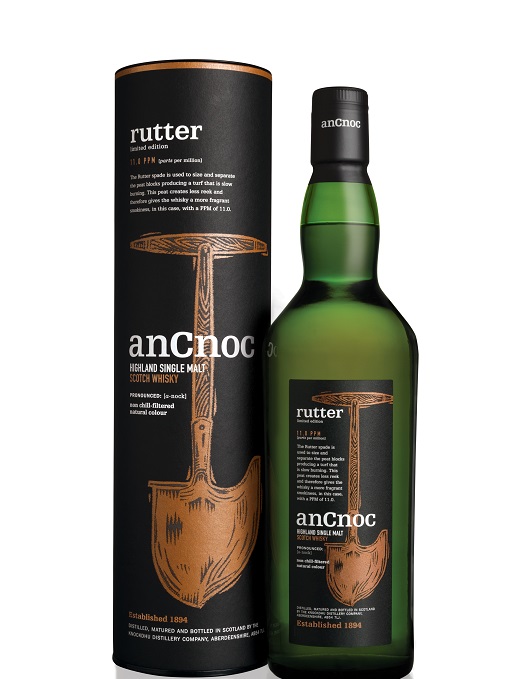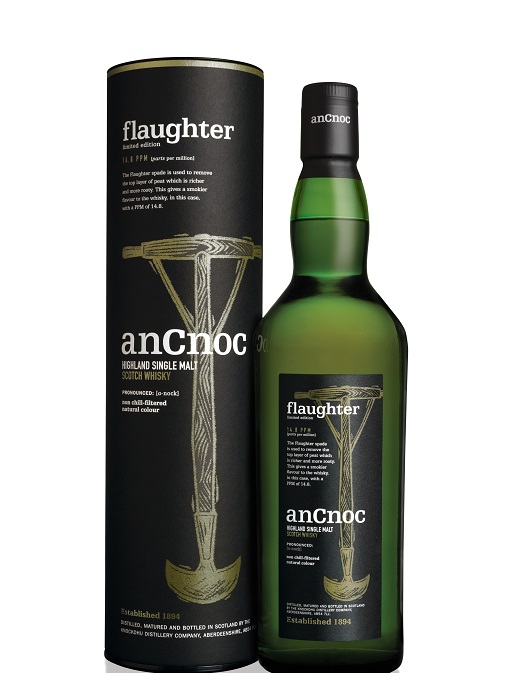I hate gardening. Now, don’t get me wrong – I love flowers and plants and shrubs and trees but all that down on your knees, in the dirt, back breaking, sweating under the hot sun stuff you can keep. Why, I know folks who love gardening so much that they have their favorite tools, gardening clothes and a thousand and two rituals to go along with them that they claim make them ecstatic. Personally, a dry martini with no dirt sipped in the shade makes me ecstatic, but then, that’s just me.
Some of these folks have even gone so far as to name their favorite tools. My neighbor has a rake he calls Earl and a small hand shovel he has christened Sandy. I always had my doubts about his sanity, but now I’m pretty sure. Well, it turns out that amateur gardeners are not the only ones who name their tools. Now to me, a shovel is pretty much just a shovel, but to the Scottish folks who produce this anCnoc Scotch, a shovel is either a Flaughter or a Rutter or even a Tushkar, and the one thing all these christened shovels have in common is Peat; let me explain.
Peat or turf is an accumulation of partially decayed vegetation or organic matter that is the most efficient carbon sink on the planet. The peat plants capture the CO2, which is naturally released from the peat. Peat forms in wetland conditions where flooding prevents the flow of oxygen from the atmosphere, slowing rates of decomposition, which is why they keep finding all those well preserved Bronze age and Iron age Druid bodies with intact clothes and skin and all. Peat accumulations are known as mires or bogs or even fens and another thing they all have in common is that peat is an important source of fuel and often the precursor to the formation of other fossil fuels like coal. Those wiley Scottish folks also discovered that when you burn the stuff it gives off a wonderful smoky aroma, so naturally, the first thing they did with it right after popping a bag of peat flavored popcorn was smoke the sprouting barley they used for distilling Scotch, which they discovered was far tastier than that popcorn.
The Scots so love their peat that they have fabricated special shovels for harvesting the stuff, and anCnoc has named their three peaty, smoky scotches after those very shovels. This is gardening at a whole higher level than I have even dreamt about. Flaughter scotch is named after the spade used to remove the top richer and rooty layer of peat and this Scotch is peated to 14.8ppm (parts per million of yummy phenol). The rutter spade is used to size and separate the peat blocks producing a turf that is slow burning. The Rutter scotch weighs in at 11ppm. And last, but not least, is the tushkar named after the spade that has a long blade that cuts down through the peat, producing a turf with a medium to slow burn and a scotch with a PPM of 15.0
All that being said, and trust me that is the most gardening talk I have ever engaged in, let’s not get bogged down (get it?) and give two of these scotches a try. Yeah, I know I just discussed three scotches but their goofy PR people only provided me a few drops of just two so I can only do what I can do.
I’ll start with the Rutter at 11 ppm. The nose is quite smoky and peaty in a vegetative type of way. There is very little alcohol in this nose. Under all that smokiness, I can just barely sense the scotch and traces of vanilla and tobacco and leather. The palate duplicates the nose with the smokiness front and center followed by the scotch and vanilla and some banana, and even with all that going on, it is quite smooth. The finish is a bit less smoky but still very flavorful, full and smooth and lasts a fair amount of time. I have to admit that I really like the added smokiness in this scotch; it gives it a dimension lacking in milder scotches. On the rocks, the smokiness becomes less defined but still presents a palateful of taste that is not diminished in the finish. If you like your scotch brimming with flavor, this just might be your cup of tea.
The Flaughter at 14.8 ppm is next. Oddly enough, I thought that the higher the ppm number the stronger the smokey flavor profile would be, but that seems to be quite the opposite. (I would have loved to do a second round of tasting to confirm this observation but there just barely enough for the first round.) The Flaughter has about half to one third the smoky nose of the Rutter but still possesses all the other qualities of vanilla, tobacco and leather and maybe some apricot but is just much milder. The palate still has a very smoky profile up front but again not as intense as the Rutter. This really is the laid back cousin of the first scotch. The finish is smooth and medium in length and leaves a touch of the smoke and leather behind. There’s a lot of depth and complexity here even though the flavors are not as intense. That does not make it inferior to the first just different and pleasant in its own way. On the rocks, the Flaughter mellows out but the smokiness is still out front but now the scotch actually has a fighting chance to make its presence known and it is quite tasty. The finish is now more balanced, and I can make out the other flavors more readily.
If you’re a hardcore scotch drinker and want the most flavor and smokiness for your buck, then the Rutter is definitely the way to go. However, if you want a more balanced scotch with a slightly less smoky profile, then the Flaughter is your choice. Either way you choose, you won’t be disappointed.
These fine scotches will run you around $70.00 per bottle, wherever you might find them, but the price is well worth the experience.
By George Brozowski














